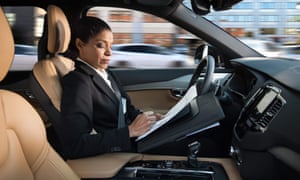Next-level driverless cars: how to solve the problem of humans falling asleep
Next wave of development will see drivers only expected to intervene when the car requests it, say researchers

Studies have shown that drivers can fail to spot when systems reach their limits and can have trouble retaking control of the vehicle, especially in an emergency.
Photograph: Volvo/AFP/Getty Images
Driving down the motorway in a swanky semi-autonomous car, the vehicle is at its own wheel, humming along smoothly. But coming off a slip road it is over to you. The only trouble is, you’ve fallen asleep.
The goal of a completely driverless car is considered top of a six-level scale of autonomy, and researchers believe it will one day be possible to achieve that aim. But for now, cars are stuck at level two on the scale – in which the driver must still perform several key aspects of driving – while engineers work out how to crack the problem of keeping drivers alert.
However, researchers say they are working on sensor-based systems to provide an answer and move towards level three, in which the driver would only be expected to be ready to intervene when the car requests it.
It’s an issue that has been underscored by recent cases of drivers ending up in accidents while their level two car was apparently on autopilot. “Under level three you’re not allowed to sleep, you need to be there and able to do things. But you don’t need to drive all the time. You can have your office there, or relax. Then the system tells you, ‘OK, in 10 minutes you need to take over’,” said Anna Anund of the Swedish National Road and Transport Research Institute, who is presenting research into tackling this transition point at the meeting of the American Association for the Advancement of Science this week.
By tapping into our understanding of sleep, stress, inattention and anxiety in humans, and knowledge of challenges such as weather and road conditions, Anund and colleagues are working on sensor-based systems to spot when the transition from car to driver might be hazardous, and ensure drivers can take the helm safely. The systems, it seems, will be sophisticated.
“It will not spray water in your face,” said Anund, who is leader of a project focusing on developing software for such sensor systems. “If we are talking about truck drivers, their main problem is they have been driving on the motorway too long doing nothing. Then the countermeasure could be to communicate [with] the driver, ask them to do things,” she said. “If you are driving in the middle of the night, then nothing will help except stopping.”
The idea is far from sci-fi: General Motors has already announced that its Cadillac Super Cruise will include eye-tracking technology.
But Anund says the systems could involve many types of sensor. “This is not retinal cameras only,” she said. “In a motorbike we can have sensors in protective gear – gloves, jacket, helmet. Also we can have sensors in the drivers’ seat. It’s not a sensor developing project. These sensors exist. It’s about using them.”
Should the sensors spot that a driver at the controls is becoming sleepy, or is drunk, the system could also prompt the car to take over, Anund added. “This is a critical state – for you and for anyone oncoming and passing you,” she said.
Ian Reagan, from the Insurance Institute for Highway Safety in the US, said it was important to tackle the issues around semi-autonomous cars.
“Anything less than fully automated driving will introduce new challenges for the people who ride along. Experimental studies demonstrate that drivers can fail to notice when systems reach their limits and can have trouble retaking control of the vehicle, especially in emergency situations.”
Level three autonomy, he noted, presents an inherent difficulty. “Drivers are given permission to turn their attention elsewhere but must be ready to take control at a moment’s notice,” he said. “Automated systems need to be programmed to seek a safe state on their own, such as pulling to the side of the road and stopping, without depending on human drivers to take over.”